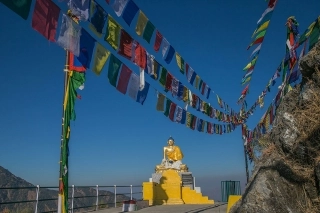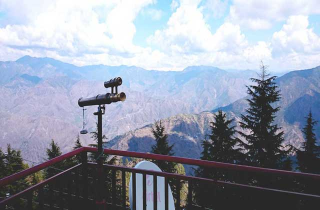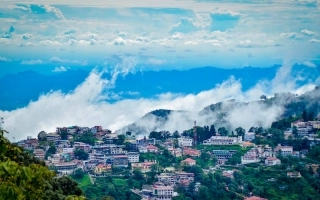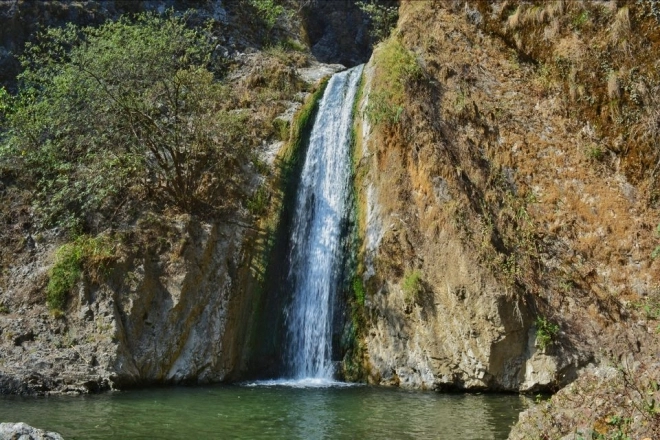Mussoorie is a hill station and a municipal board in the Dehradun District of the Indian state of Uttarakhand. It is about 35 kilometres (22 mi) from the state capital of Dehradun and 290 km (180 mi) north of the national capital of New Delhi. The hill station is in the foothills of the Garhwal Himalayan range. The adjoining town of Landour, which includes a military cantonment, is considered part of 'greater Mussoorie', as are the townships of Barlowganj and Jharipani.
Mussoorie is at an average altitude of 1,880 metres (6,170 ft). To the northeast are the Himalayan snow ranges, and to the south, the Doon Valley and Shiwalik ranges. The second highest point is the original Lal Tibba in Landour, with a height of over 2,275 metres (7,464 ft). Mussoorie is popularly known as The Queen of the Hills.
Mussoorie was founded by Lt. Frederick Young of East India Company. Lt. Young came to these hills for the purpose of shooting game.
He was so enamoured by the beauty that he decided to build a hunting lodge (shooting box) on the Camel's Back Road with FJ Shore, Jt. Magistrate of Doon in 1823. He raised the first Gurkha Regiment and planted the first potatoes in the valley. His tenure in Mussoorie ended in 1844 and he further served in Dimapur and Darjeeling and retired as a General and went back to Ireland.[citation needed] There are no memorials to commemorate Young in Mussoorie. However, there is a Young Road in Dehradoon on which ONGC's Tel Bhawan stands.
In 1832 Mussoorie was the intended terminus of the Great Trigonometric Survey of India that began at the southern tip of India. Although unsuccessful, the Surveyor General of India at the time, George Everest wanted to have the new office of the Survey of India based in Mussoorie. A compromise was to have it in Dehradun, where it still is.[citation needed]
In 1850 the first beer brewery in India was built in Mussoorie. By 1894 there were 22 breweries in India producing 6 million gallons a year.
By 1901 Mussoorie's population had grown to 6,461, rising to 15,000 in the summer. Earlier, Mussoorie was approachable by road from Saharanpur, 58 miles (93 km) away. Accessibility became easier in 1900 with the railway coming to Dehradun, thus shortening the road trip to 21 miles (34 km).
Mussoorie view from the top of the hill (can be viewed while traveling on the way towards down of the hill)
The name Mussoorie is often attributed to a derivation of 'Mansoor', a shrub which is indigenous to the area. The town is often referred to as 'Mansoori' by most Indians.
The main promenade in Mussoorie is called, as in other hill stations, the Mall. In Mussoorie, the Mall stretches from Picture Palace at its eastern end to the Public Library at its western end. The Nehru family, including Nehru's daughter Indira (later Indira Gandhi), were frequent visitors to Mussoorie in the 1920s, 1930s and 1940s, and stayed at the Savoy Hotel. They also spent much time in nearby Dehradun, where Nehru's sister Vijayalakshmi Pandit ultimately settled full-time.
During the 1959 Tibetan Rebellion, the Central Tibetan Administration of the 14th Dalai Lama was at first established in Mussoorie before being moved to its present location in Dharamsala, Himachal Pradesh. The first Tibetan school was established in Mussoorie in 1960. Tibetans settled mainly in Happy Valley. Today, some 5,000 Tibetans live in Mussoorie.
Mussoorie today has increased the development of hotels and tourist lodges, given its relative proximity to Delhi, Ambala, and Chandigarh, and has serious problems of garbage collection,[according to whom?] water scarcity and parking shortages, especially during the summer tourist season. Landour, Jharipani and Barlowganj have fewer such problems.
Nahata Estate: Previously known as "Childer's Lodge", Nahata Estate is a property of more than 300 acres (120 ha), owned by the Harakh Chand Nahata family. It is the highest peak of Mussoorie near Lal Tibba with mountain views, 5 km (3 mi) from the Tourist Office.
Gun Hill: A honeymooning couple on Gunhill in Mussourie
Gun Hill is the second highest point of Mussoorie, at an altitude of 2,024 m (6,640 ft) located at 30.4953°N 78.0745°E
Kempty Falls: The Kempty Falls are on the hilly tracks of Uttarakhand, India, 15 km (9.3 mi) from Mussoorie along Kempty Fall Road. This place is nearly 1,364 m (4,475 ft) above sea level at 78°-02’ East longitude and 30° -29’ North latitude. The curious name of this waterfall is derived from the words ‘camp-tea’, which was popularised by British tea parties here during the colonial era. The falls are also a popular swimming and fishing destination in Mussoorie.
Lake Mist: About 5 km (3 mi) before Kempty Falls on the Mussoorie-Kempty road is Lake Mist, through which flows the Kempty river with its numerous small waterfalls. The resort of Lake Mist provides accommodation, restaurant facilities and boating.
Municipal Garden: The Municipal Garden provides an artificial mini-lake with paddle boats. It is 4 km (2.5 mi) by road transport and 2 km (1 mi) via Waverly Convent School road on foot.
Bhatta Falls: Bhatta Falls is 7 km (4.5 mi) from Mussoorie on the Mussoorie-Dehradun Road near the village of Bhatta. The falls are 3 km (2 mi) by foot from Bhatta.
Mussoorie Lake: The newly developed Mussoorie Lake was built by the City Board and Mussoorie Dehradun Development Authority. The lake, providing pedal boats and views of Doon Valley and nearby villages is 6 km (3.5 mi) from Mussoorie on the Mussoorie-Dehradun road.
Jharipani Fall: Jharipani Fall is 8.5 km (5.5 mi) from Mussoorie on Mussoorie-Jharipani road. From Jharipani fall is approximately 1.5 km (1 mi) by foot.
Mossy Fall: Mossy Fall is surrounded by a dense forest and is 7 km (4.5 mi) from Mussoorie, and is accessed via Barlowganj or Balahisar.
Sir George Everest's House: At Park Estate are the remains of the building and laboratory of Sir George Everest, the Surveyor-General of India from 1830 to 1843. It is after George Everest that the world's highest peak Mt. Everest is named. It is 6 km (3.5 mi) from Gandhi Chowk and a scenic walk from Library Bazaar, although accessible by road transport to at least Haathi Paon. The place provides a view of Doon Valley on one side and a panoramic view of the Aglar River valley and the peaks of the Himalayan ranges on the other. It is a scenic walk from Library Bazaar.
Happy Valley: At Upbeat Valley is the IAS Academy, Tibetan sanctuaries and the Municipal Garden. The range of the valley lies on the western side of Library Point and prompts the Cloud's End, a place where land fringes of Mussoorie end.
Nag Devta Temple: The ancient Nag Devta Temple is dedicated to Snake God Lord Shiva, It is on Cart Mackenzie Road about 6 km (3.5 mi) from Mussoorie on the road to Dehradun. There is vehicular access to the temple, which provides a view of Mussoorie and the Doon Valley.
Jwalaji Temple (Benog Hill): At an altitude of 2,240 m (7,350 ft), this temple is in the 9 km (5.5 mi) west of Mussoorie. It is at the top of Benog Tibba (Hill) and contains an old idol of Goddess Durga. There is a view of the Aglar River valley. The temple cannot be accessed by vehicle although a motor road goes most of the way from Mussoorie.
Cloud End: Cloud End is surrounded by thick deodar forest. The bungalow, built in 1838 by a British major, was one of the first four buildings in Mussoorie and has been converted to a hotel.
Van Chetna Kendra: Van Chetna Kendra is 11 km (7 mi) to the south of Library Point, and is a sanctuary established in 1993, and covers an area of 339 hectares (840 acres). It is significant for the extinct bird species Mountain Quail (Pahari Bater), which was last spotted in 1876.
Benog Wildlife Sanctuary: This one is about 11 kilometers from Library Point but still interesting for those who like bird watching and the wildlife. Old-cedar trees and many medicinal plants growing in abundance along with pine trees will give a lot of happiness to a nature lover's heart. Plus there are chances of spotting The White Capped Water Redstart and the Red Billed Blue Magpie, or a panther, leopard, deer, bear and Himalayan goats if you are very lucky.
Mall Road: The Mall is a renowned shopping district situated in the heart of Mussoorie. It is dotted with shops, cafes and a host of colonial remnants that point to Mussoorie's past glories. There are several video game parlours and skating rinks here for travellers to revel in entertainment activities. The Mall also has a Methodist church and the Tibetan market place nearby makes for a diverse cultural mix.
Lal Tibba: Lal Tibba is the highest point in Mussoorie and offers a panoramic view of the town and its surroundings. The place is famous for a Japanese telescope which was placed here in 1967. One can view Badrinath, Kedarnath, Banderpunch and other Himalayan ranges from this telescope. Lal Tibba is also called Depot Hill due to the presence of a military depot here in earlier times.
Top Trending Attractions in Mussoorie

The Happy Valley in Mussoorie holds a high significance in Mussoorie as is an integral part of the culture of Mussoorie now. It ...

Lal Tibba is the highest peak's topmost point and most famous place in Mussoorie. Popular among tourists and travellers for ...

Landour, a small cantonment town contiguous with Mussoorie, is about 35 km (22 mi) from the city of Dehradun in the northern ...
In and Around Mussoorie
Mussoorie
Population :30,118
Languages :Hindi, Garhwali, English
Pincode :248179
Travel Insight

Six people Vivek, Amby, Saurabh, Varun, Ruchika and Shibba were ready ...

Ranthambore Fort is a formidable fort situated near Sawai Madhopur ...
Top travel News

Bihar Utsav 2025 at Dilli Haat, INA, is a must-visit event for ...

Greater Noida is all set to host a spectacular Flower Show at City ...

Aadi Mahotsav 2025 is more than just a festival; it is a ...

Amrit Udyan, a symbol of natural beauty and serenity, is set to ...
Essential India
Your trip to India is incomplete if you have not...- Danced to a punjabi number
- Tasted the spicy street food
- Picked up a local Rajasthani dress and jutti (footwear)
- Tried an ayurvedic full-body massage
- Watched a classical dance performance
- Taken a train





